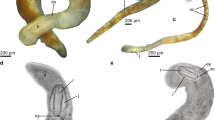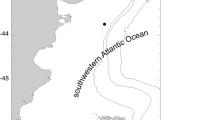Summary
Male and female echinoids are almost always separate, and seldom exhibit pronounced sexual dimorphism. In the most extreme previously known examples of sexual dimorphism, ova, zygotes, and juveniles are housed in a shallow depression in the surface of the test, or in a deepened petaloid ambulacrum. A new species of urechinid holasteroid,Urechinus mortenseni, is described in which juveniles are brooded inside a deeply invaginated extension of the body wall suspended from the interior edges of the female's apical plates. Although technically not inside the test, the juveniles are completely invisible from the exterior, and are contained in a series of brood pouches that communicate with the environment only through a small opening at the apex. This is the first complete description of brooding in the Holasteroida. The morphology of the brooding system is described, and a new terminology is erected to refer to the completely novel features of the system: the apical aperture, birth canal, and brood pouches. The plating, spines, and pedicellariae of the brooding system are also described. The salient characteristics of the brooding system found inU. mortenseni are contrasted with those of brooding strategies in other echinoderms. The new species is compared with other holasteroids. For the first time, a brooding system is also described inPlexechinus nordenskjoldi, which implies that it is closely related toU. mortenseni. This casts doubt on the integrity of the two genera, and suggests that a phylogenetic revision is required to highlight the unique features found not only in these unusual urechinids, but in other holasteroids as well.
Similar content being viewed by others
References
Agassiz A (1904) The Panamic Deep Sea Echini. Mem Mus Comp Zool Harvard Coll 31:1–243
David B (1988) Origins of the deep-sea holasteroid fauna. In: Paul CRC, Smith AB (eds) Echinoderm phylogeny and evolutionary biology (Chapter 25). Clarendon Press, Oxford, pp 331–346
David B, Néraudeau D (1989) Tubercle loss in Spatangoids (Echinoidea, Echinodermata): original skeletal structures and underlying processes. Zoomorphology 109:39–53
David B, Sibuet M (1985) Distribution et diversité des échinides. In: Laubier L, Monniot C (eds) Peuplements profonds du golfe de Gascogne (Chapter 43). Ifremer, Paris, pp 509–534
David B, Laurin B, DeRidder C (1988) HowEchinocardium cordatum (Pennant) shows sexual dimorphism. In: Burke RD, Mladenov PV, Lambert P, Parsley RL (eds) Proc 6th Int Echinoderm Conf, Balkema, Rotterdam, pp 683–686
Fell FJ (1976) The Cidaroida (Echinodermata: Echinoidea) of Antarctica and the Southern oceans. Thesis, University of Maine, 294 pp
Fell HB (1946) The embryology of the viviparous ophiuroidAmphipholis squamata Della Chiaje. Trans R Soc New Zealand 75:419–464
Hyman LH (1955) The Invertebrates (vol 4): Echinodermata. McGraw-Hill, New York, 763 pp
Kasyanov VL (1984) Sexual dimorphism in sea urchinsStrongylocentrotus nudus, S. intermedius andScaphechinus mirabilis (in Russian). Zool Zh 63:1745–1748
Kier PM (1969) Sexual dimorphism in fossil echinoids. In: Westermann GEG (ed) Sexual dimorphism in fossil metazoa and taxonomic implications. Int Union Geol Sci Ser A, 1:215–222
Lawrence JM (1987) A functional biology of Echinoderms. Croom Helm, Beckenham, 340 pp
Lovén S (1874) Etudes sur les échinoïdées. Kongl Sven Vetens Akad Handl 11:1–91 + atlas 53 plates
Lovén S (1883) OnPourtalesia a genus of Echinoidea. Kongl Sven Vetens Akad Handl 19(1881):1–95
Mironov AN (1976) Deep-sea urchins of the northern Pacific (in Russian). Tr P P Shirshov Inst Okeanol 99:140–164
Mironov AN (1978) Meridosternin echinoids collected by the 16th cruise of the R/V “DM Mendeleyev” of the northern Pacific (in Russian). Tr P P Shirshov Inst Okeanol 113:208–226
Mooi R (1986) Structure and function of clypeasteroid miliary spines (Echinodermata, Echinoides). Zoomorphology 106:212–223
Mooi R (1989) Living and fossil genera of the Clypeasteroida (Echinoidea: Echinodermata): an illustrated key and annotated checklist. Smithson Contrib Zool 488:1–51
Mooi R (1990) Paedomorphosis, Aristotle's lantern, and the origin of the sand dollars (Echinodermata:Clypeasteroida). Paleobiology 16:25–48
Mortensen T (1936) Echinoidea and Ophiuroidea. Discovery Reports 12:199–348
Mortensen T (1950a) Echinoidea. In: British Australian New Zealand Antarctic Research Expedition, 1929–1931. Rept BANZAR Exped, Ser B Zool Bot 4:287–310
Mortensen T (1950b) A monograph of the Echinoidea V Spatangoida. Vol 1. Reitzel ca, Copenhagen, 432 pp
Néraudeau D (1990) Ontogenèse, paléoécologie et histoire desHemiaster, échinides irréguliers du Crétacé. Thèse Doctorat, Université Bourgogne, 194 pp
Oguro C, Shosaku T, Komatsu M (1982) Development of the brittle-starAmphipholis japonica Matsumoto. In: Lawrence JM (ed) Proc 4th Int Echinoderm Conf Balkema, Rotterdam, pp 491–496
Schatt P (1985) L'édification de la face orale au cours du développement direct deAbatus cordatus, oursin incubant subantarctique. In: Keegan BF, O'Connor BDS (eds) Proc 5th Int Echinoderm Conf Balkema, Rotterdam, pp 339–345
Smith AB (1980) Stereom microstructure of the echinoid test. Spec Pap Palaeontol 25:1–81
Tahara Y, Okada M, Kobayashi N (1960) Further notes on the sexual dimorphisms in Japanese sea urchins. Publ Seto Mar Biol Lab 8:183–189
Turner RL, Dearborn JH (1979) Organic and inorganic composition of post-metamorphic growth stages ofOphionotus hexactis (EA Smith) (Echinodermata:Ophiuroidea) during intraovarian incubation. J Exp Mar Biol Ecol 36:41–51
Author information
Authors and Affiliations
Rights and permissions
About this article
Cite this article
David, B., Mooi, R. An echinoid that “gives birth”: morphology and systematics of a new Antarctic species,Urechinus mortenseni (Echinodermata, Holasteroida). Zoomorphology 110, 75–89 (1990). https://doi.org/10.1007/BF01632814
Received:
Issue Date:
DOI: https://doi.org/10.1007/BF01632814




